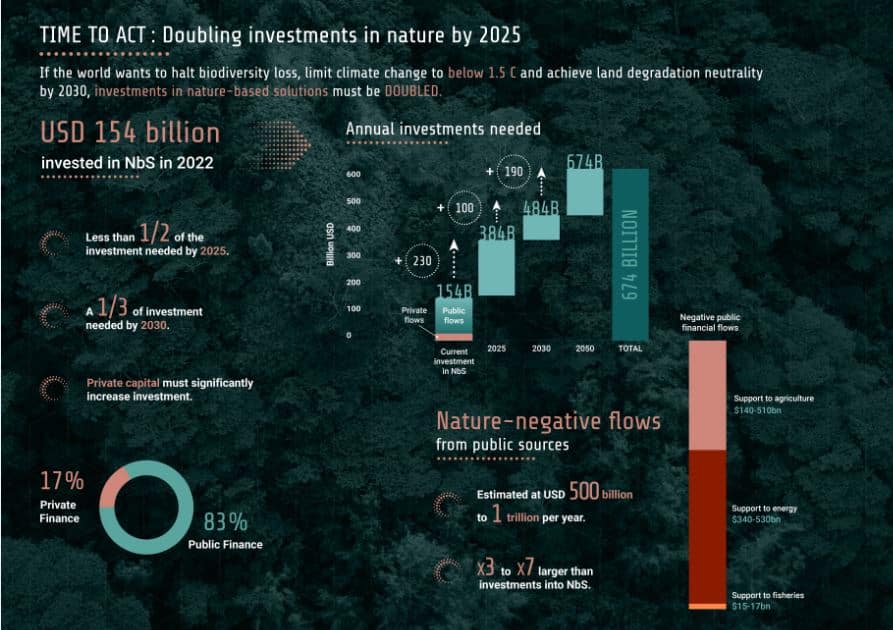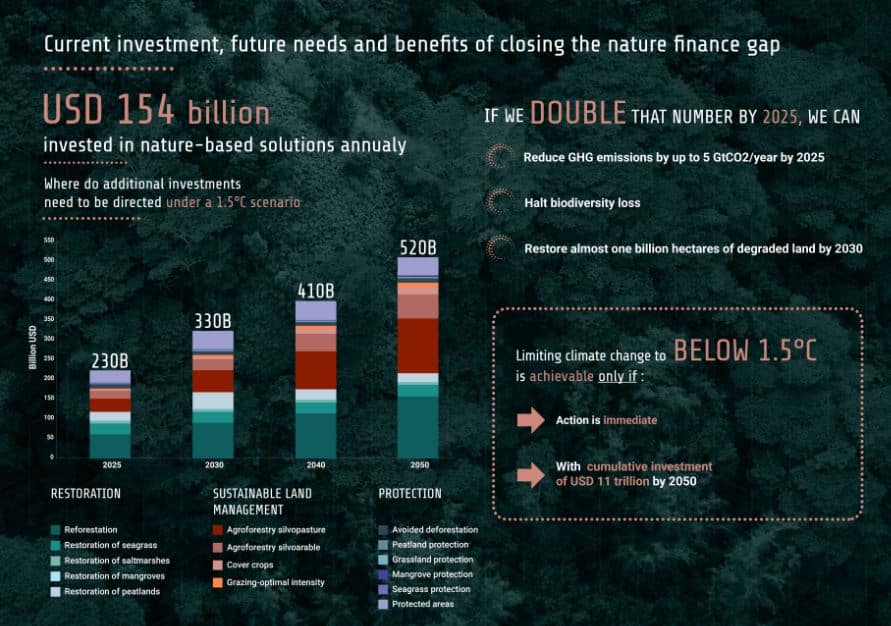Investments into Nature-Based Solutions (NBS) have to be more than double their current levels, reaching $384 billion a year by 2025 and $674 billion by 2050 to deal with the global crises of climate change, biodiversity loss and land degradation, according to a UN report.
The UN report entitled the “State of Finance for Nature” said that doubling investments into protecting and managing the world’s ecosystems is the key to address those triple crises. The authors reveal that NbS are still significantly under-financed.
The report comes 10 days after the end of the COP27 and a week before the start of the UN Conference on Biodiversity (COP15 CBD) in Montreal, Canada. COP15 is where nations will try to agree on a deal to protect nature and wildlife from further losses and degradation.
Authors of the report said in a statement that UNEP urges governments to come up with an agreement at COP15 mandating countries to require the financial sector to align investments with nature-positive goals.
Investments in Nature-Based Solutions (NBS)
According to one of the authors who is the director of McKinsey & Company Robin Smale, Nature-based Solutions refer to:
“Actions to protect, conserve, restore, sustainably use and manage natural or modified terrestrial, freshwater, coastal and marine ecosystems, which address social, economic and environmental challenges effectively and adaptively, while simultaneously providing human well-being, ecosystem services and resilience and biodiversity benefits are all considered as nature-based solutions…”
The current global investments in NB$&%S are around $154 billion per year. But that amount has to increase to $384 billion by 2025 to tackle the triple crisis of land degradation, climate, and nature as the chart shows.
Last year, investments into nature-based solutions was at around $133. But this estimate will be altered as the scope of NbS and how they’re assessed keeps on changing, too. Take for instance the case of marine NbS; they are the newest inclusion to the report’s latest edition.
- In contrast, investments from governments in economic activities that pollute the air are 3x to 7x higher than financing for NbS.
These subsidies are highest in the sectors of energy and agriculture estimated at $340 billion – $530 billion a year and $500 billion a year, respectively. The report suggested phasing out of these investments.
Nature and The Economy
The authors of the report further noted that:
“This report is a reminder that lots of short-term efforts to boost gross domestic product (GDP) by Governments… without paying attention to the fact that nature underpins many economies, will impose greater costs for both present and future generations in the years to come.”
In fact, about 50% of global GDP is dependent on healthy and well-functioning ecosystems. So, countries have to go beyond just the economics of GDP and consider the principles of natural capital accounting and circular economy.
According to one author, there are already trends pointing to that direction and considering nature in making investment decisions.
Meanwhile, the report also found that governments spend $500 billion-$1 trillion a year on potentially damaging subsidies. And with ~100 parties to last year’s biodiversity summit in Kunming, China, they weren’t able to agree to fund nature conservation efforts in poorer countries.
Over a decade ago in Japan, world leaders who signed a biodiversity pact in 2010 have set targets to cut loss by 2020. Unfortunately, none of those goals were also met.
NbS and Carbon Markets
The third major point of UNEP’s report was the need for private investments in nature-based solutions.
Financing from the private sector accounts for only 17% despite their pledges to reduce deforestation and carbon emissions. With this, the report recommended that private investors will have to “combine ‘net zero’ with ‘nature positive’.”
That means they must do the following actions:
- Create a sustainable supply chain
- Reduce activities that negatively impact climate and biodiversity,
- Offset any unavoidable activities through high-integrity nature markets,
- Pay for ecosystem services, and
- Invest in nature-positive activities.
Closing the nature-finance gap means directing additional investments in ecosystem restoration, protection, and sustainable land management. The chart below shows how much financing NbS requires to meet the 1.5 degree scenario.
Carbon markets have a role to play in propelling private financing for NbS. And public investments can’t scale up soon due to several issues that governments face, said the report. So working on creating standards and ensuring integrity in carbon markets is crucial.
An officer from the UNEP noted that including NbS in the COP climate summit agenda wasn’t possible before. Making it to the cover text of COP27 and the upcoming COP15 in Montreal is a success.
Discussions on mitigation finance were still not enough but “ambition without finance does not lead to action” the officer said. Financial commitments are vital for negotiations to be in good faith, she added.
The report was released by the UNEP along with the Federal Ministry for Economic Cooperation and Development (BMZ) of Germany, the UN Convention to Combat Desertification (UNCCD) and the European Commission.



